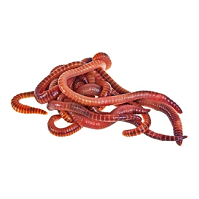Live red worms: Tips for care a worm bin
Every Little Thing You Need to Know About Red Wigglers for Composting
Red wigglers, or Eisenia fetida, play a critical role in the world of composting, transforming natural waste right into valuable soil changes. The procedure of establishing up a worm container and keeping it can position challenges.
What Are Red Wigglers?

(red wigglers for sale cheap)
Indigenous to North America, red wigglers are surface-dwelling microorganisms that prefer moist, cozy environments rich in breaking down natural matter. Their diet consists largely of rotting plant material, food scraps, and other organic particles, which they eat and break down efficiently. As they absorb this product, they produce nutrient-rich castings that boost soil fertility.
Red wigglers are hermaphroditic, having both male and female reproductive body organs, and can replicate swiftly under optimal conditions. Generally, red wigglers are important factors to the procedure of recycling natural waste right into important garden compost.
Advantages of Making Use Of Red Wigglers
Using red wigglers in composting systems supplies numerous advantages that improve both the efficiency of waste monitoring and the quality of the resulting compost. These worms, medically called Eisenia fetida, are particularly efficient at damaging down raw material, transforming kitchen area scraps and yard waste right into nutrient-rich garden compost at an accelerated rate.
One of the primary advantages of utilizing red wigglers is their capability to eat huge amounts of natural product, typically processing their weight in food waste daily. This high usage rate leads to quicker decomposition and minimizes the volume of waste sent out to landfills. Moreover, the spreadings produced by red wigglers are abundant in crucial nutrients, beneficial microorganisms, and enzymes, making them a superb fertilizer for gardens and plants.
Additionally, red wigglers prosper in a variety of atmospheres, making them adaptable for both interior and exterior composting systems - red wigglers. Their existence in a compost bin helps to aerate the product, stopping odors and promoting a healthy and balanced composting process. Generally, employing red wigglers not just adds to effective waste administration but additionally supports lasting horticulture practices via the manufacturing of premium garden compost
(red wigglers for sale)
Setting Up Your Worm Container
To effectively establish a worm container, it is important to choose a suitable container that fulfills the demands of red wigglers while providing a conducive atmosphere for composting. An appropriate bin can be made from plastic, wood, or metal, with a capacity of a minimum of 1 square foot for every pound of worms.
Make certain the container has sufficient drain holes to avoid excess wetness, as red wigglers thrive in a wet, yet not water logged, setting. red wigglers. The container must likewise be ventilated to offer sufficient airflow, preventing anaerobic problems that can damage the worms
An ideal location for the worm bin is a trendy, dark area, cost-free from direct sunlight and severe temperature levels, as red wigglers like a temperature level variety of 55 to 77 degrees Fahrenheit.
Before presenting the worms, prepare bedding products such as shredded paper, cardboard, or coconut coir, which will certainly provide both environment and food. Dampen the bedding lightly to develop a welcoming setting for the worms. Finally, think about placing a cover on the container to maintain humidity and decrease bugs, while ensuring it can be conveniently gotten rid of for upkeep.
Feeding and Treatment Guidelines
Feeding red wigglers is a crucial facet of keeping a healthy composting system. These worms thrive on a diverse diet plan, mostly composed of natural materials such as fruit and veggie scraps, coffee grounds, and smashed eggshells. It is vital to avoid feeding them meat, dairy, and oily foods, as these can produce undesirable odors and draw in insects.
When presenting food to your worm container, slice or shred materials right into smaller items to facilitate quicker decay. Start with little amounts to assess the worms' consumption rate, progressively increasing the quantity as they adjust. It is advisable to alternating feeding areas within the bin to urge comprehensive blending and aeration of the garden compost.

Troubleshooting Common Issues
Maintaining a flourishing worm composting system can occasionally present difficulties that call for interest and troubleshooting. Usual issues include an undesirable smell, which commonly suggests overfeeding or the presence of anaerobic problems. To correct this, minimize the quantity her response of food included and make certain appropriate oygenation by blending the bed linen material.
One more regular trouble is the escape of worms from the container. This can happen due to excessive moisture or improper ecological conditions. Regularly inspect the moisture degrees, intending for a moist yet not soaked uniformity, and preserve ideal temperature levels in between 60-80 ° F(15-27 ° C )to develop a comfy environment for your red wigglers.
Insects, such as fruit flies, can also attack worm containers. red wigglers. To battle this, cover food scraps with a layer of bedding or shredded paper to hinder flies from laying eggs. Furthermore, make certain that any type of food included is fresh and without mold, which can attract unwanted parasites
Finally, if your worms seem inactive, check for tension elements such as temperature changes or insufficient moisture. Resolving these typical concerns will certainly assist preserve a healthy and productive worm composting system.
Conclusion
In summary, red wigglers, or Eisenia fetida, play a vital function in sustainable waste monitoring through vermicomposting. Their capability to efficiently transform natural waste right into nutrient-dense castings enhances dirt health and wellness and advertises plant development. Proper configuration and upkeep of a worm container, along with adherence to feeding guidelines, ensure a growing ecological community that lessens land fill payments. Addressing common problems immediately better sustains the performance of this ecological technique, adding to ecological sustainability and agricultural productivity.